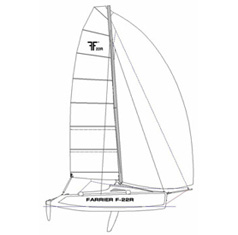
Got around to making a mobile fiberglass cart today. I decided to make it on wheels so that I could roll it around to the end of the Strong Back, making it easier to lay down a long length of fiberlass. Or, I can roll it down the side of the float for cutting smaller sections of fiberglass. Materials used were 3/4 inch plywood, scrap MDF boards from my form frames, 2x6's, and 2x4's. Everything is screwed and glued, with construction adhesive holding the 2x6's onto the base. I decided to use closet rods to hang the fiberglass rolls, but the full rolls (weighing 110 pounds) sag a little in the middle. I suggested to Andrew that he try using the smaller diameter posts that are used for building a chain-link fence instead.

 I cut a four foot section of foam and clamped that to the keel batten. Then I took a Japanese-style pull saw (with a thin, flexible blade), and using the keel foam as a guide, cut the proper angle on the foam planks.
I cut a four foot section of foam and clamped that to the keel batten. Then I took a Japanese-style pull saw (with a thin, flexible blade), and using the keel foam as a guide, cut the proper angle on the foam planks. 
 After all the planks were cut, I slipped in the keel foam so that it was flush with the top of the keel batten. The foam was about 2 inches high, and I cut back where the form frames interfered on the bottom using a Stanley Surform pocket plane. By the way, you can replace the Surform blade with a Micoplane blade for better/faster results. I finished up by screwing the foam keel in from the back side of the keel batten.
After all the planks were cut, I slipped in the keel foam so that it was flush with the top of the keel batten. The foam was about 2 inches high, and I cut back where the form frames interfered on the bottom using a Stanley Surform pocket plane. By the way, you can replace the Surform blade with a Micoplane blade for better/faster results. I finished up by screwing the foam keel in from the back side of the keel batten. Layed down the first set of foam strips today! I decided to experiment with the width and started off with about a 15" wide piece. This seemed a little too wide for the middle section. I finally decided that around 10" worked good. Here's what seemed to work so far:
Layed down the first set of foam strips today! I decided to experiment with the width and started off with about a 15" wide piece. This seemed a little too wide for the middle section. I finally decided that around 10" worked good. Here's what seemed to work so far:



 Decided to try using MDF as battens. I ripped a bunch of 12 foot 1x6's into 1" strips and put them down every 3-4 inches. I think they came together pretty nicely in the stern. The bow gave me a little trouble, but I think I came up with a good solution.
Decided to try using MDF as battens. I ripped a bunch of 12 foot 1x6's into 1" strips and put them down every 3-4 inches. I think they came together pretty nicely in the stern. The bow gave me a little trouble, but I think I came up with a good solution.
 The frames are temporarily held in place using scrap wood until I can attach the battens.
The frames are temporarily held in place using scrap wood until I can attach the battens.











